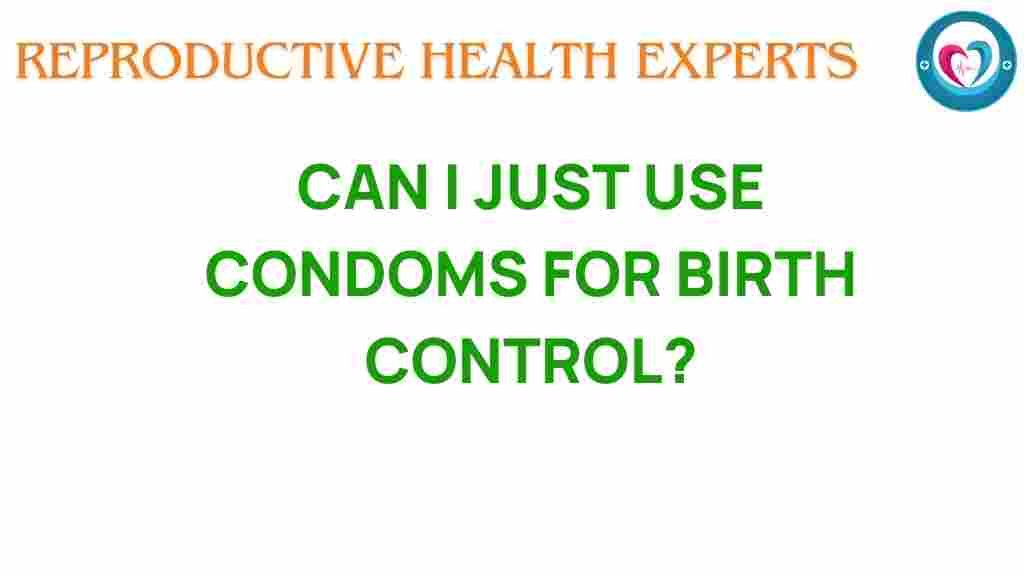The Truth About Condoms: Are They Enough for Birth Control?
When it comes to family planning and sexual health, many individuals and couples consider various forms of contraception. Among the most popular methods are condoms, which are widely known for their effectiveness in preventing pregnancy and sexually transmitted infections (STIs). However, the question remains: are condoms enough for birth control? In this article, we will delve into the effectiveness of condoms, their role in contraception, and their impact on sexual health.
Understanding Condoms and Their Effectiveness
Condoms are a barrier method of contraception made from latex, polyurethane, or polyisoprene. They are designed to be worn on the penis during intercourse, providing a physical barrier that prevents sperm from entering the vagina. Here are some key points regarding their effectiveness:
- Pregnancy Prevention: When used correctly, condoms are about 98% effective in preventing pregnancy. However, typical use, which includes human error, brings this number down to around 85%.
- STI Prevention: Condoms are the only form of contraception that also provide protection against STIs. They can significantly reduce the risk of transmission of diseases such as HIV, gonorrhea, and chlamydia.
- Accessibility: Condoms are widely available without a prescription and can be purchased at pharmacies, grocery stores, and online.
How to Use Condoms Effectively
To ensure that condoms provide the maximum level of effectiveness in birth control, it’s essential to use them correctly. Here is a step-by-step process:
- Check the Expiration Date: Always check the expiration date on the condom package before use.
- Open Carefully: Open the condom package carefully to avoid damaging the condom with your teeth or sharp objects.
- Pinch the Tip: Pinch the tip of the condom to leave a small space for semen and roll it down the erect penis.
- Use Lubrication: If needed, use a water-based or silicone-based lubricant to reduce friction and the chance of breakage. Avoid oil-based lubricants as they can weaken the condom.
- Withdraw Carefully: After ejaculation, hold the base of the condom while withdrawing to prevent it from slipping off.
- Dispose Properly: Wrap the used condom in tissue and dispose of it in the trash. Do not flush it down the toilet.
Common Misconceptions About Condoms
Despite their popularity, there are several misconceptions regarding the use of condoms and their effectiveness:
- Myth 1: Condoms are not necessary if you use other forms of birth control.
Fact: While other methods can be effective at preventing pregnancy, only condoms provide protection against STIs. - Myth 2: Condoms reduce pleasure during sex.
Fact: Many people find that using condoms can enhance pleasure when combined with lubricants. - Myth 3: All condoms are the same.
Fact: There are various types of condoms available, including ultra-thin, textured, and flavored options, which can cater to different preferences.
Considerations for Sexual Health and Birth Control
While condoms are an effective form of contraception, they may not be the best option for everyone. Here are some factors to consider when evaluating your reproductive choices:
- Reliability: If used consistently and correctly, condoms are reliable; however, some people may prefer other methods that require less attention and maintenance.
- Allergies: Some individuals may have latex allergies. In such cases, polyurethane or polyisoprene condoms may be better alternatives.
- Personal Preferences: It’s essential to discuss with your partner what method of contraception works best for both of you, considering comfort and effectiveness.
Combining Condoms with Other Contraceptive Methods
For those seeking a higher level of protection against pregnancy, combining condoms with other forms of birth control can be an effective strategy. Here are some methods that complement condom use:
- Hormonal Birth Control: Methods such as the pill, patch, or injection can provide reliable pregnancy prevention when used alongside condoms.
- IUDs: Intrauterine devices (IUDs) are highly effective and can be used in conjunction with condoms for added protection.
- Emergency Contraception: In case of a condom failure, emergency contraception can be used to prevent pregnancy.
Troubleshooting Common Issues with Condoms
While condoms are generally reliable, issues can arise. Here are some common problems and how to troubleshoot them:
- Breakage: If a condom breaks during intercourse, stop immediately and assess the situation. Consider using emergency contraception if necessary.
- Slippage: If the condom slips off, ensure it is properly fitted and consider using a smaller size or different brand.
- Allergic Reactions: If you or your partner experience irritation or allergic reactions, switch to non-latex options.
Conclusion: Making Informed Reproductive Choices
In summary, condoms are a highly effective method of birth control that also provides protection against STIs. While they are an excellent option for many, it’s crucial to consider individual circumstances and preferences when making decisions about contraception and sexual health. Combining condoms with other methods can enhance effectiveness and cater to personal needs.
Ultimately, the choice of contraception is a personal one, and it’s important to communicate openly with your partner and possibly consult with a healthcare professional to find the best solution for your family planning needs. For more information on sexual health and contraception options, visit the Planned Parenthood website.
Remember, taking charge of your reproductive choices empowers you to lead a healthier and more fulfilled life. Whether you choose condoms or explore other methods, ensure you are informed and proactive in your sexual health decisions.
For more detailed insights on effective contraception methods, feel free to check out our comprehensive guide on family planning resources.
This article is in the category Birth and created by ReproductiveHealthExperts Team
